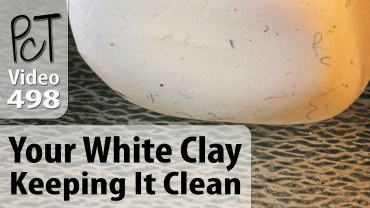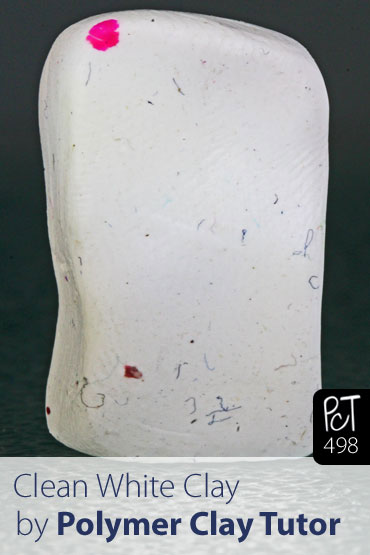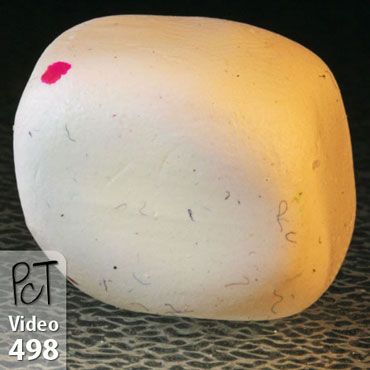Having A Hard Time Keeping Your White Clay Clean?
Video #498: Here’s some quick tips to help you keep the lint, fuzz and pet hairs at bay, so that your whites stay white.
More...
IN THIS POST: — white polymer clay — dirty clay — clean clay — dust free — lint — fuzz — pet hair — baby wipes — rubbing alcohol — (Topics marked with an asterisk* are discussed in the Comments Section below).
Topics Covered In This Video:
- Tips for Keeping Your Polymer Clay Clean.
- Light colors like white polymer clay get dirty very easily.
- Avoid getting clay dirty in the first place.
- Don’t wear fluffy clothing like scarves and sweaters.
- No pets in studio when working with raw white clay.
- Keep work area clean and dust free.
- Wipe surfaces with baby wipes or damp cleaning cloths.
- Sticky lint rollers will help pick up dust.
- Keep hands your super clean. Use sugar scrubs or other abrasive cleansers on hands to get lines and fingerprints clean.
- Roll soft translucent polymer clay in your hands to pick up any bits of dirt or clay that might be on your hands while working on your projects.
- Once hands are clean, avoid touching clothing.
- Keep pasta machine, tools and all surfaces as clean as possible.
- In a future video, I will show you how to remove dirt from polymer clay if it has already got onto the surfaces.
00:00:03 –> 00:00:07 Hi guys, its Cindy Lietz, your Polymer Clay Tutor, and today’s Studio Tip, we’re talking
00:00:07 –> 00:00:10 about keeping your Polymer clay clean.
00:00:10 –> 00:00:17 Now, has this ever happened to you before, you have a pristine block of White clay and
00:00:17 –> 00:00:22 you cut off a piece, and you start rolling it around your hands, trying to make something,
00:00:22 –> 00:00:29 and you’re rolling it on your surface, and within a few seconds, it’s covered in dirt
00:00:29 –> 00:00:35 and lint and all kinds of little flecks and stuff, and it’s really, really frustrating.
00:00:35 –> 00:00:39 So, I have several tips I’m gonna share with you today that you can help to avoid
00:00:39 –> 00:00:42 getting it dirty in the first place.
00:00:42 –> 00:00:47 First thing that you’re gonna wanna do is watch what you’re wearing, now, all fluffy
00:00:47 –> 00:00:53 scarves, sweaters that kind of stuff, don’t wear it in the studio, get rid of it.
00:00:53 –> 00:00:57 Cats, dogs, I mean I know a lot of you guys like to have your pets around you when you’re
00:00:57 –> 00:01:02 working, don’t work with…don’t have them in there when you are working with White
00:01:02 –> 00:01:09 Polymer clay, get them out, get your area nice and clean and then it should really help.
00:01:09 –> 00:01:13 Now, there’s a bunch of ways to get it clean, sometimes, you know it looks pretty clean
00:01:13 –> 00:01:18 here, I haven’t got a lot of stuff sitting around, but you’d be surprised how much
00:01:18 –> 00:01:21 dirt and lint and things are here.
00:01:21 –> 00:01:26 So the first thing you’re gonna wanna do is get some baby wipes and wipe down your
00:01:26 –> 00:01:33 whole area, make sure it’s nice and clean, also, a great thing to do is to use something
00:01:33 –> 00:01:41 like one of these sticky things…these sticky roller…lint picker-uppers, just wipe your
00:01:41 –> 00:01:46 whole…go around your whole surface, all the areas where you’re working, and pick
00:01:46 –> 00:01:53 up all the lint, and even just a few seconds here and I’ve got lots of lint here.
00:01:53 –> 00:02:00 Also, make sure that your hands are super clean, I’ve got hands with really, really
00:02:00 –> 00:02:08 deep veins…or finger prints and little markings and stuff on it, my hands will trap all kinds
00:02:08 –> 00:02:12 of things in them, even when they seem clean, I’ve washed them, what you can do is use
00:02:12 –> 00:02:17 one of those nice sugar scrubs or something and get them really, really clean.
00:02:17 –> 00:02:25 Another thing I like to do is roll a piece of Translucent clay in my hands to just pick
00:02:25 –> 00:02:28 up any little bits of dirt…this is after I’ve scrubbed them and they are nice and
00:02:28 –> 00:02:32 clean, it’ll just make sure that I’m not…
00:02:32 –> 00:02:34 I haven’t got anything stuck to my hands.
00:02:34 –> 00:02:39 Also, once your hands are clean, don’t be touching your jeans and stuff all the time,
00:02:39 –> 00:02:46 if I just quickly set this lint thing on my jeans, you can see how much little tiny fibers
00:02:46 –> 00:02:51 are on your clothing, so if you just try to avoid touching your hands and then back to
00:02:51 –> 00:02:56 the surface, that will really help.
00:02:56 –> 00:03:03 Of course, keep your pasta machine really clean, your tools really clean, just try to
00:03:03 –> 00:03:07 keep the area as clean as possible, in a future video I’ll show you how to get rid of some
00:03:07 –> 00:03:11 of that…if you have got it on your clay pieces, but we’ll save that for another
00:03:11 –> 00:03:12 day.
00:03:12 –> 00:03:17 So I hope these tips were helpful for you, if they were, make sure to let me know if
00:03:17 –> 00:03:19 you like this video or not.
00:03:19 –> 00:03:25 And in the comments sections, make sure to let me know if there’s something that is
00:03:25 –> 00:03:31 a problem for you, if you’d like me to show you a video on how to solve that, that would
00:03:31 –> 00:03:34 be great, leave those in the comment section below.
00:03:34 –> 00:03:36 And we will see you next time, bye for now.
Our goal is to translate these videos into as many languages as possible. If you are interested in helping with this initiative, then please do contact us and we will figure out a way to make it worth your while :)
Resource Links:
- Related Video: Polymer Clay Pasta Machine Cleaning Tip 1 Baby Wipes
- Related Video: Using Translucent Clay To Clean Pasta Machine Tip 3
Resources marked with a double ** asterisk are affiliate links. If you click on them and decide to buy something, we may receive some compensation. This does not affect the price you pay in any way. What it does do, however, is helps us to continue providing free videos for you, here at the PcT website. Using our links to purchase your tools and supplies, is always greatly appreciated.
Sponsored Ads & Special Promotions

Shareable Images



To share this full blog post anywhere on the web that allows links in comments, here's a shortened url to copy and paste...
>> https://mypct.ca/v498 <<
Want to chat about today’s post? That’s what the comment section below is for. Scroll Down… We’d love to hear from you!
Or... if you would like to request a topic for a future post, here is the link to do that… PcT Suggestion Box

This comment is about CLEANING YOUR HANDS, which can help when switching to white clay, or just to have clean hands after finished.
Keeping clean clay is so important, but what about your hands when you are finished. Well after watching a YouTube about cleaning epoxy brushes, I applied it to my polymer clay hands….AND IT WORKS! First spray about 3 sprays of baking spray (I use Pam) in the palm of one hand. Then about 3 pumps of GermX on top of the baking spray in your palm, then a drizzle of dishwashing liquid on top of both (I use Dawn). Rub hands together briskly, and use fingernail brush on nails and hands. Rinse with warm water, and follow up with soap and water. I rarely have to repeat. Results…..CLEAN HANDS. This also works for epoxy brushes in a small Dixie cup.
That sounds like a very interesting tip Janice! I will have to remember to try that. Thanks for letting us know about it!
Hi….I’ve tried making zebra print beads using fimo classic clay, and no matter how many times I wash my hands and my blade and work surface I still manage to get black mixing with the white resulting in a dirty looking bead, have you got any tips please to keep this from happening?….thanks
Hi Steve, Fimo will dissolve a little when exposed to water, so make sure your hands are clean and dry before trying to roll them in your hands. A little cornstarch rubbed into your hands will help, especially if your hands tend to sweat a little. This is not as much an issue when you work with Premo since it won’t break down with water. Hope that helps!
Hi Cindy,
Since watching some of your videos I feel like I’ve learned a great deal about finishing my pc pieces. I was wondering one thing though: I have been sanding my pieces with 3m sandpaper found at Canadian Tire using 400 grit all the way down to 1500, and I still find that I have a white residue-like film on my pieces. I then use felt to make it shine but the white film is still there. How do I get rid of this film? I use water with a drop of dish soap, so I don’t know what I’m doing wrong. Do you have any suggestions?
Hi Angela, I am not totally sure what is happening here. What brand of polymer clay are you using? Maybe the water is a problem for it?
Hi Cindy! I am just beginning my journey into polymer clay and have become very interested in your videos. I like your short teaching techniques. Thank you for teaching in such a way even an ol’ girl like me can understand.
Donna
Just wondered where you got those wonderful wall storage units with the drawers on your work table!
Just what I have been looking for. Thanks!
Suzanne
Hi Suzanne, here is the video that I did on that storage unit…
Plastic Drawer Storage Cabinet For Polymer Clay
…and btw, I bought mine at a store here in Canada called Canadian Tire, but there are lots of places you can buy them, including online.
Hi Cindy,
I am addicted to your Youtube channel and website. You have saved me from so many mistakes and honestly disasters. Thank you!
I have a question for you about photographs and resin. I am going to be creating my own jewelry bezels for my bracelets and necklace line. I have clients that send me their personal photographs and I cut and glue them in and put a resin topcoat to seal in the images. Is there are particular brand of glue that you would recommend using with polymer clay?
Also, have you done any experiments with resin on top of clay? Any bleeding or improper mixing of elements?
Thanks so much for all your help and guidance. Huge fan and keep up the good work. So excited to start trying your color palettes. They are amazing!!!
Kim Kelly
Bay Girl Designs
Hi Kim, thank you for all your kind words! I really appreciate hearing that from you. As far as glue goes, you have several options… in fact if you type glue into the search box at the top of the page you will get several answers that may help you. For something like that I would use either Weldbond or E6000. Either are compatible with polymer and will hold very well.
Love your tutorials. You’ve motivated me to try polymer clay.
I happen to be using white clay on a project and use alcohol to clean my work surface. At one time baby wipes had alcohol in them but many now are alcohol free and contain aloe or glycerine. But the even the alcohol free wipes do a good job of cleaning my work surface. I was at Walgreen’s last night to pick up some 91% rubbing alcohol. I was pleased to see thy had it in a spray bottle, this will be great when cleaning my pasta machine. They also had wipes with 70 percent alcohol. I found these in the first aid section of the store.
Love the lint roller idea! Another thing I never thought of was to use translucent clay to pick up excess stuff from off my hands. Wonderful ideas! Even us old diehards need to be reminded once in awhile to keep our areas clean. Thank you Teacher!
Cindy, another suggestion packed video, especially love the idea of using the lint roller brush. Thanks!